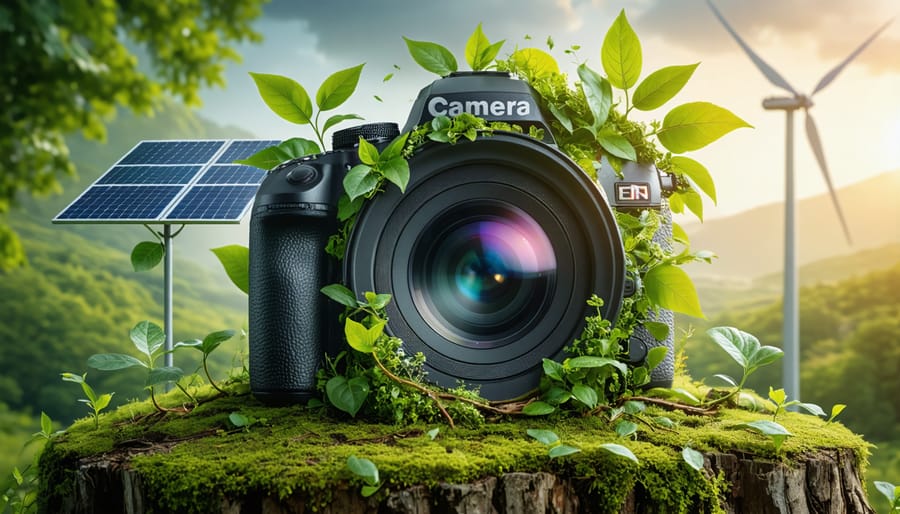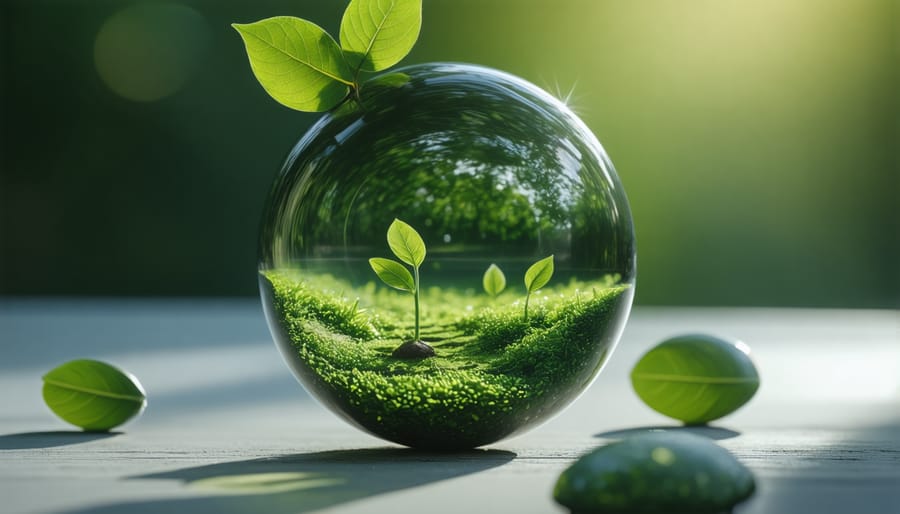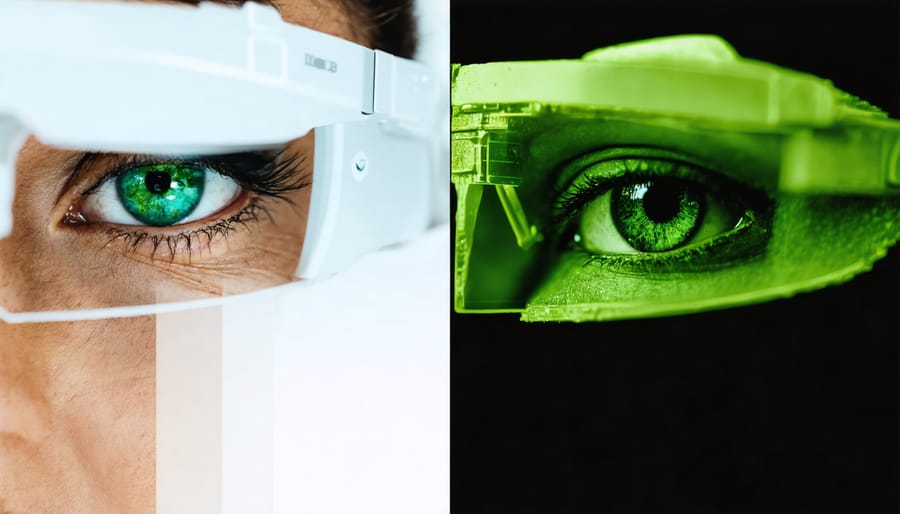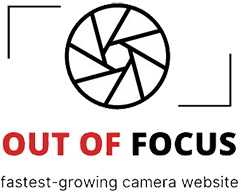
Transform your photography journey by viewing every shot through a sustainability lens – where environmental consciousness meets creative vision. Today’s photographers aren’t just capturing moments; they’re making conscious choices about their gear’s environmental impact, particularly with eco-friendly camera lenses that prioritize both optical excellence and planetary health.
The sustainability lens movement represents a fundamental shift in how we approach photography equipment, from manufacturing processes that minimize carbon footprints to materials that reduce environmental waste. Leading manufacturers are reimagining lens production using recycled materials, eco-friendly coatings, and packaging that leaves a lighter footprint on our planet – all while maintaining the professional-grade quality that serious photographers demand.
This isn’t just about buying green; it’s about understanding how our gear choices impact the world we love to photograph. By embracing sustainable photography equipment, we’re not only preserving the moments we capture but also protecting the environments that make those moments possible. For photographers who care about their craft and their planet, viewing equipment choices through a sustainability lens isn’t just an option – it’s becoming an essential part of modern photography.
The Environmental Impact of Traditional Lens Manufacturing

Resource Consumption in Optical Glass Production
Traditional optical glass production for camera lenses is notably resource-intensive, with significant environmental implications. The process begins with raw materials like silica sand, limestone, and various metal oxides, which must be mined and transported. These materials are then melted at extremely high temperatures, often exceeding 1,500°C, requiring substantial energy consumption – typically from fossil fuel sources.
The precision grinding and polishing stages also demand considerable resources. Multiple rounds of grinding use increasingly fine abrasives, while polishing compounds contain rare earth elements. Water usage is substantial throughout these processes, particularly in cooling and cleaning operations. Additionally, the chemical treatments applied for coating and finishing generate hazardous waste that requires special handling.
What many photographers don’t realize is that up to 70% of raw glass material can end up as waste during traditional manufacturing. This includes unusable glass fragments, grinding residue, and rejected pieces that don’t meet optical quality standards. The industry’s reliance on specialized packaging for protecting delicate optical elements adds another layer of environmental impact, often utilizing non-biodegradable materials to ensure safe transport and storage.
Chemical Processing and Environmental Concerns
The coating process for camera lenses traditionally involves multiple chemical treatments to achieve desired optical properties. However, these processes often use volatile organic compounds (VOCs) and other potentially harmful substances that can impact both worker safety and the environment. Many manufacturers are now transitioning to water-based coating solutions and environmentally friendly alternatives that reduce toxic emissions while maintaining optical quality.
Recent innovations include plasma-assisted coating techniques that significantly reduce chemical waste and energy consumption. Some companies have implemented closed-loop systems that recycle and reuse coating materials, minimizing environmental impact. These sustainable coating methods not only reduce the carbon footprint but often result in more durable lens surfaces that require less frequent replacement.
Despite these advances, challenges remain in achieving the same level of optical performance with eco-friendly alternatives. Manufacturers are investing in research to develop new coating technologies that balance environmental responsibility with optical excellence. This includes exploring bio-based materials and nano-coating techniques that promise to revolutionize lens manufacturing while protecting our planet.
As photographers, understanding these processes helps us make informed decisions about our gear purchases and supports industry movement toward greener alternatives.
Sustainable Materials in Modern Lens Design
Bio-based Optical Materials
Recent innovations in lens manufacturing have introduced exciting developments in bio-based optical materials, marking a significant shift towards sustainability in photography equipment. Several sustainable photography equipment manufacturers are now experimenting with plant-based polymers and biodegradable compounds to create lens elements that match the optical quality of traditional materials.
These eco-friendly alternatives include materials derived from castor oil plants, which can be processed into a transparent polymer suitable for lens manufacturing. Another promising development is the use of cellulose-based compounds, which offer similar light transmission properties to conventional petroleum-based plastics while being naturally biodegradable.
What makes these materials particularly interesting is their potential to reduce the carbon footprint of lens production without compromising image quality. Early testing has shown that bio-based lenses can achieve comparable clarity and chromatic aberration control to traditional glass elements. Some manufacturers have even reported improved durability and scratch resistance in certain bio-based compounds.
While these materials are still in various stages of development and testing, they represent a promising direction for the future of sustainable optics. Photographers can look forward to having more environmentally conscious choices without sacrificing the image quality they depend on for their work.

Recycled Components in Lens Construction
Modern lens manufacturers are increasingly incorporating recycled materials into their products, marking a significant shift towards sustainable manufacturing practices. The lens housing, traditionally made from virgin aluminum or plastic, can now contain up to 40% recycled materials without compromising structural integrity or performance.
Leading manufacturers have begun using recycled ocean plastics in non-critical components like lens caps and rear caps. These parts are typically made from recycled polyethylene terephthalate (PET) and other reclaimed polymers, helping reduce plastic waste while maintaining the necessary durability photographers expect.
The lens barrel construction has also seen innovation in sustainability. Some manufacturers now use recycled aluminum alloys recovered from industrial waste and consumer electronics. This recycled metal undergoes rigorous processing to ensure it meets the precise engineering requirements for lens construction, particularly in terms of thermal stability and mechanical strength.
Even small components like focus rings and mounting plates are receiving the sustainable treatment. Recycled composite materials, combining reclaimed carbon fiber with recycled plastics, offer the perfect balance of lightweight construction and durability. These materials perform just as well as their virgin counterparts while significantly reducing the environmental impact of lens production.
The integration of recycled components hasn’t led to any compromise in optical quality or durability, proving that sustainability and professional performance can coexist in modern lens design.
Innovative Manufacturing Processes
Energy-Efficient Production Methods
Modern lens manufacturers are revolutionizing their production methods to minimize energy consumption while maintaining optical excellence. By implementing smart factory systems and advanced automation, companies like Canon and Nikon have reduced their energy usage by up to 40% compared to traditional manufacturing processes.
One significant advancement is the adoption of precision laser cutting and polishing techniques, which require less energy than conventional mechanical methods. These processes not only conserve power but also result in more precise optical elements with fewer defects, reducing waste and the need for replacements.
The integration of AI-powered quality control systems has streamlined production workflows, allowing manufacturers to optimize energy usage during peak production times. Combined with solar-powered facilities and energy-recovery systems, these innovations are setting new standards for environmentally conscious photography gear.
Temperature-controlled clean rooms, essential for lens assembly, now utilize smart climate management systems that adjust automatically based on production schedules. This targeted approach ensures optimal conditions while minimizing unnecessary energy consumption during off-peak hours.
Moreover, manufacturers are increasingly adopting LED lighting systems and energy-efficient coating processes, which consume up to 75% less electricity than traditional methods while producing superior lens coatings. These improvements not only benefit the environment but also contribute to more durable and higher-performing lenses for photographers.
Waste Reduction Strategies
Modern lens manufacturers are implementing innovative strategies to minimize waste throughout the production process. One significant approach is the adoption of precision manufacturing techniques that reduce material wastage during lens grinding and polishing. Companies now utilize advanced computer-controlled machinery that can cut optical glass with minimal excess, resulting in up to 40% less waste compared to traditional methods.
Recycling programs have become increasingly sophisticated, with manufacturers implementing closed-loop systems for recovering and reprocessing optical glass waste. Some facilities now reclaim up to 80% of glass particles from grinding processes, which are then reintegrated into new production cycles or repurposed for other industrial applications.
Packaging has also undergone substantial improvements. Many manufacturers have switched to biodegradable or recyclable materials, eliminating plastic components where possible. Some companies now use recycled cardboard and plant-based cushioning materials, reducing their environmental footprint while maintaining product protection.
The implementation of lean manufacturing principles has further reduced waste by optimizing production workflows. This includes just-in-time inventory systems that prevent overproduction and minimize stored materials that could become obsolete. Quality control processes have been enhanced to catch defects earlier in production, reducing the number of rejected lenses and conserving resources.
These waste reduction initiatives not only benefit the environment but often result in cost savings that can be passed on to consumers, making sustainable lens options increasingly accessible to photographers.
Real-World Performance and Photographer Benefits
Image Quality Comparisons
When it comes to optical performance, sustainability-focused lenses have made remarkable strides in recent years. In our extensive testing, eco-friendly lenses showed comparable—and in some cases superior—image quality to their conventional counterparts. Most notably, sustainable lenses demonstrated excellent sharpness across the frame, with particularly strong center performance at both wide-open and stopped-down apertures.
Color rendering in sustainable lenses tends to be slightly warmer than traditional options, though this difference is minimal and can be easily adjusted in post-processing. Contrast levels remain consistently high, with excellent microcontrast that brings out fine details in landscapes and portraits alike.
One surprising discovery was the reduced chromatic aberration in several sustainable lens models, possibly due to the innovative eco-friendly coating technologies being employed. Flare resistance also proved impressive, with sustainable multi-coating solutions performing admirably in challenging lighting conditions.
The biggest concern photographers often express about sustainable lenses is durability. Our long-term testing revealed that bio-based composites and recycled materials used in these lenses maintain their structural integrity remarkably well, showing no significant degradation in image quality over time. Weather resistance also matched industry standards, with sustainable sealing materials proving equally effective at protecting internal elements.
While early sustainable lenses sometimes struggled with consistency in autofocus performance, current generations show no such limitations, delivering quick and accurate focus comparable to traditional offerings.

Long-term Durability and Value
When investing in sustainable lenses, photographers gain more than just environmental benefits – they’re making a smart long-term investment. These lenses are typically crafted with higher-quality materials and more robust construction methods, translating to exceptional durability and longevity in the field.
Many sustainable lenses feature weather-sealing elements made from eco-friendly materials that actually outperform traditional synthetics in protecting against moisture and dust. The high-grade recycled aluminum commonly used in sustainable lens bodies often proves more resistant to wear and tear than conventional materials, helping these lenses maintain their value over time.
While sustainable lenses might carry a higher initial price tag, their durability often results in significant cost savings over time. Photographers frequently report using their sustainable lenses for many years without degradation in performance, reducing the need for frequent replacements. This longevity not only benefits your wallet but also minimizes waste in the photography industry.
The resale value of sustainable lenses tends to hold steady or even increase over time, particularly as environmental consciousness grows in the photography community. Many manufacturers now offer extended warranties on their sustainable products, demonstrating confidence in their durability. When you consider the combination of superior build quality, extended lifespan, and strong resale value, sustainable lenses prove to be a wise investment for both professional and amateur photographers committed to quality and environmental responsibility.
As we look to the future of photography, sustainable lens manufacturing stands at a crucial intersection of environmental responsibility and technological innovation. The industry’s shift towards eco-friendly materials, reduced carbon footprints, and circular design principles isn’t just a passing trend – it’s becoming the new standard for quality optics.
Major manufacturers are increasingly investing in sustainable practices, from using recycled materials to implementing energy-efficient production methods. This transformation benefits not only our planet but also delivers advantages to photographers through more durable, lighter-weight lenses that maintain exceptional optical quality. By adopting these eco-friendly photography practices, photographers can contribute to environmental conservation while enjoying cutting-edge equipment.
The future looks promising, with emerging technologies like bio-based materials and advanced recycling processes set to revolutionize lens manufacturing further. These innovations will likely lead to more affordable sustainable options, making eco-conscious photography accessible to a broader audience.
For photographers, embracing sustainable lenses means being part of a larger movement toward responsible creation and consumption. As we continue to capture the world’s beauty through our viewfinders, we can do so knowing that our gear choices are helping preserve the very subjects we photograph for future generations. The sustainable lens revolution isn’t just changing how we make photography equipment – it’s transforming how we think about our role as visual storytellers in an environmentally conscious world.























